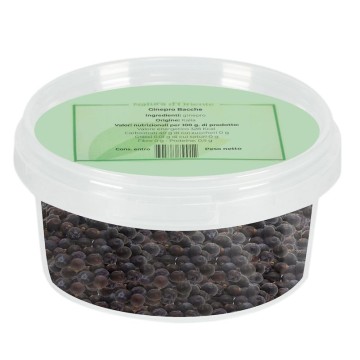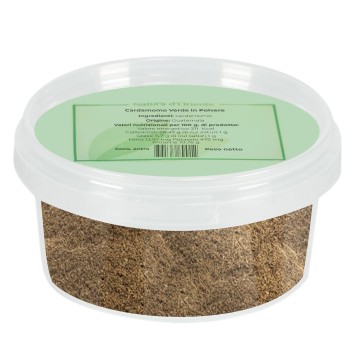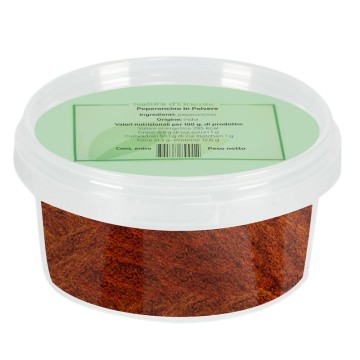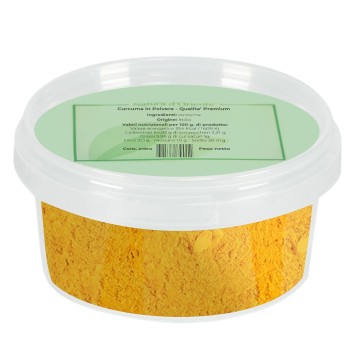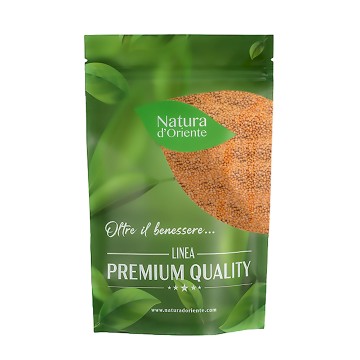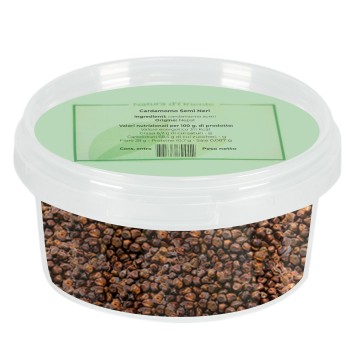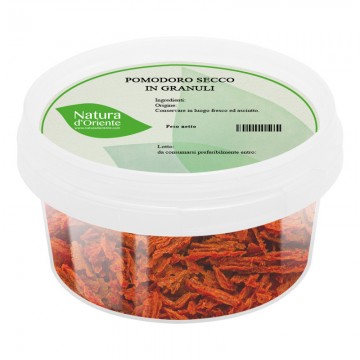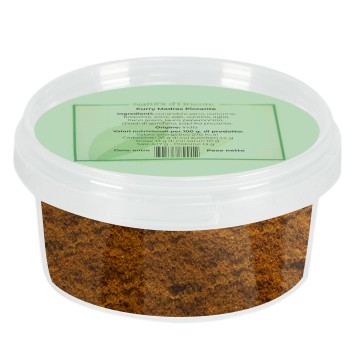The powdered version of Harissa is a blend of dried spices, which derive from the North African tradition. In Tunisian cuisine, in particular, the Harissa seasoning is pungent and earthy, based on smoked chili peppers. Its pleasantly warm and medium-hot taste, with the aroma of paprika, combines with other spicy elements, which give a slightly honeyed flavor and a fruity note, very appetizing. It is a well-balanced composition, with characteristics that make this North African specialty so popular in our cuisine too. It is usually obtained from the combination of red chili peppers, cumin, coriander, kummel, garlic, smoked paprika and salt. Its strong peppery and smoky flavor, can vary the heat level depending on the type of chili pepper used. This blend of ground Tunisian Harissa has a complex flavor, and lends itself well to emulating the taste of the typical sauce of the same name, which we could define as a “pepper pesto” made from dried red chili peppers.
The Herbs and Spices of Harissa
This versatile harissa recipe is complex: warm, slightly smoky, savory and spicy enough to season many dishes. Coriander releases intense aromas that evoke dill, fennel and notes of citrus. The sweet taste and citrus aftertaste pair well with cumin. Cumin infuses a subtle pungency, balancing the heat of the chili peppers. Its warm scent can release toasted notes, which pair well with paprika. Garlic releases a strong and pungent taste on the palate, recognizing it as a full-bodied element of the blend; it enhances the spicy notes and balances the delicate ones. Chillies provide the intense heat, stimulating the pungency on the palate and creating the desired heat effect in Harissa. Kummel (caraway Carum carvi) gives the blend a pungent yet fresh, anise-like taste. Popular for flavoring stewed meats. Cayenne pepper is the hottest spice, with sharp, pungent notes; with an intense, pungent aroma, it creates a versatile base for seasoning many dishes. Paprika adds a spicy, smoky note to the blend, with a hint of bitterness appreciated for giving depth to Harissa powder. Dried tomato thickens the blend, gives a slightly acidic flavor and enhances the taste in the preparation of Harissa sauce.
Mint provides its unique flavor, due to menthol, with pungent, warm notes but with a refreshing aftertaste. It has a sweetish aroma that pairs well with tomato and coriander.
How to use Harissa in cooking
The powdered version of the mix can be used very well as a dry seasoning on meats, or as a spice mix in recipes. Its engaging flavor must be measured taking into account the spiciness, both to avoid making the recipe too pungent, and to avoid irritating the mucous membranes, eyes and palate.
Savory recipes: it can be used to flavor soups, broths, vegetables, or in a salad dressing - it provides heat and aromatic complexity. It can become a lively and colorful garnish to sprinkle on eggs, tofu, to incorporate into chickpea hummus. It adds a pungent pinch to grilled or sautéed vegetables such as spinach and chicory. It can also be added to pasta sauces, measuring carefully as with any spicy spice mix. Harissa powder can also be used to flavor spreads and sauces for appetizers and dressings; excellent on toasted bread, mixed with yogurt.
Meat and fish: it becomes a fantastic spicy “rub” to flavor meats before roasting, frying or grilling them. It is mixed into the marinade with olive oil and spread on meat or fish, to give depth and spiciness. It can be used in place of any other spice mix in recipes such as braised meats, Indian curries, stews. Excellent on white meats of chicken, lamb or pork, it can be tasty and spicy on steaks, to be dosed carefully so as not to cover the flavors. On fish it becomes an element that enlivens less tasty recipes, and is well known on sea bass.
Harissa sauce: following the North African tradition, the ground version can be combined with lemon and olive oil and garlic, creating the famous spicy Harissa paste or sauce, for seasoning many dishes. In addition, there is also the recipe with Harissa sauce prepared with whole roasted peppers, mixed with spices and tomato sauce (for the umami factor).
North African cuisine: Harissa sauce is used as a condiment or ingredient in Tunisia, Algeria, Israel and Morocco. It can flavor couscous and other regional dishes such as lamb stew, fish or meat stew (chicken, beef, goat) withvegetables. Bread is dipped in harissa sauce and is used to season many dishes, kebabs and sandwiches, even for breakfast. It flavors meat and eggplant, fish, rice, egg dishes (such as the one-dish meal shakshouka) and lablabi (Tunisian chickpea soup). Moroccan cuisine uses harissa as a seasoning for the Berber-origin tagine (tajin) of stewed meat or fish. It is mixed with tahini sauce, a sesame-based sauce, to accompany falafel and vegetables.
Grilled Shrimp with Harissa
Ingredients
For the Harissa sauce: 2 tablespoons olive oil – 1 large garlic clove – 1 tablespoon flaked sea salt – Juice of 1 large lemon – 1 tablespoon Tunisian Harissa mix – 2 teaspoons tomato paste
For the grill: water – salt – sugar – 250 g large shrimp, peeled and shelled, tails intact – 4 radishes, thinly sliced – 1/2 cup fresh basil leaves Preparation
Combine all the ingredients for the Harissa sauce except the oil in a bowl, using a small grinder or food processor, blend and pour olive oil while chopping. Continue until you get a smooth paste, slightly chopped. If the mixture is a little dry, you can add small splashes of water to loosen it.
Place the shrimp in brine for 30 minutes (water with salt and sugar). Dry the shrimp and place them in the harissa mixture, let them marinate for 15 minutes. Prepare the grill at medium-high heat. Thread the shrimp on the wooden skewers soaked in water. Cook about 2 minutes per side, on the hot grill (be careful: they cook quickly and risk becoming tough and rubbery). The shrimp will take on the smoky flavor of the grill, and a hint of heat from the harissa.
Transfer to a plate and let cool. Combine the shrimp, radishes, basil in another large bowl, salt and pepper. Serve them as an appetizer or as a main course, if you like with a salad or other grilled vegetables.
Origins and History of Harissa
In its version of spicy paste based on hot peppers, Harissa is originally from the Maghreb and is commonly found in North African cuisine, especially in Moroccan, Algerian and Tunisian cuisine. It was born in modern times, from the importation of South American chili peppers into Maghreb cuisine thanks to trade during the Spanish occupation of Ottoman Tunisia, in the mid-sixteenth century. Furthermore, it is worth mentioning the long domination of the Ottomans in Tunisia, who from that period also brought paprika and chili peppers to other dominated countries, such as Hungary. Because of this heritage, Tunisian cuisine is the only tradition in the Maghreb that favors spicy dishes.
Harissa recipes vary by country, but most versions include spices such as cumin, coriander, and mint. Other common ingredients include tomatoes and other herbs, as well as versions with rose petals (popularized by a famous chef) and fermented onions.
Olive oil conveys the soluble aromas and makes the paste aromatic, but even in the version of the ground spice mix, Harissa is now very popular throughout the world. It is often called Tunisian Harissa because Tunisia is the country that produces and exports it the most. It is so well known that UNESCO includes it in the Intangible Cultural Heritage of Tunisia.
The term comes from the Arabic word "harasa" which means to crush, to break up, referring to the crushing of chili peppers. Because of its red color and intense flavor, it is defined abroad as the North African version of "ketchup" and Thai Sriracha sauce.






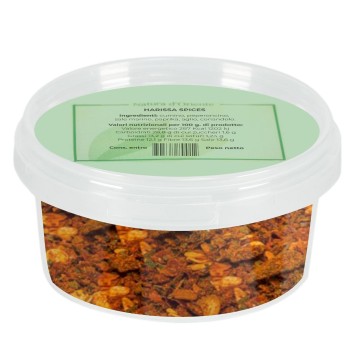




 No reward points for this product.
No reward points for this product.



